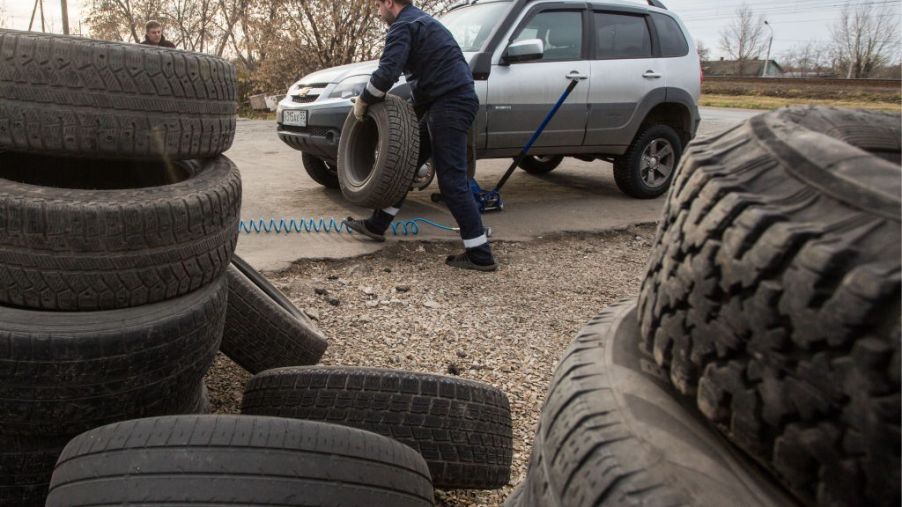
What Tools You Need to Change a Tire
Most drivers should be able to change a flat tire. Surprisingly, many don’t know how, or they don’t have what they need to accomplish the task. It’s easy to assume you can get help via your phone. But if you forget it or enter a dead zone, your phone won’t do you any good. According to Bridgestone Tire, changing a tire isn’t complicated. Here’s what you need to know.
What you’ll need
The following items should come with your vehicle. If you don’t have any of them, you should get them right away.
- Spare tire (in good condition and inflated properly)
- Jack
- Lug wrench
- Owner’s manual
Make sure to keep an eye on your spare tire. It’s a good practice to check it whenever you check your other tires. Here are some other things you should keep in your car’s trunk or glove compartment:
- Disposable poncho
- Flashlight (with extra batteries)
- Gloves
- Tire gauge
- Wheel blocks
- Wooden blocks sized to 2″x 6″ for securing the jack
Changing a tire
1. Get to safety
If you’re driving when you get a flat, pull off in a safe area with level ground and a wide shoulder. If you can park on a straight stretch of road, it’s even better for visibility. Don’t try to change your tire near oncoming traffic or in a narrow area. You can start by consulting your owner’s manual about changing a tire.
2. Let other drivers know
Turn on your hazard lights to help other drivers spot you. If you have a fluorescent orange sign, place it behind your car, too.
3. Engage the parking brake
To minimize the chance that your vehicle will move when changing the tire, apply your parking brake.
4. Place your wheel blocks
If you’re replacing a rear tire, place the wheel blocks in front of the front tires. If you’re changing a front tire, place the wheel blocks behind the rear tires. If you don’t have wheel blocks, big rocks or bricks will work if they are big enough to keep your vehicle from rolling.
5. Take off the hubcap or wheel cover
If the wheel cover conceals the lug nuts, remove them before lifting the vehicle with the jack. Otherwise, remove them later. With the flat end of the lug wrench, take off the hubcap unless it’s removed using another method. You can find instructions in your owner’s manual.
6. Loosen the lug nuts
With the wrench, loosen the lug nuts by pulling to the left in a downward motion. They will likely be really tight so you’ll need to use some force. Don’t remove the lug nuts at this point. Loosen them with a 1/4 to 1/2 turn.
7. Raise the vehicle with the jack
Place the jack under your car’s frame on the side of the flat tire. Using the manual instructions, carefully place the jack. To keep the vehicle stationary and raised, place the cut wood beneath it. Once you’ve placed the jack, lift the vehicle until the flat tire is above the ground by about six inches. Make sure no part of your body goes under the vehicle during this process.
8. Remove the lug nuts and tire
Unscrew the lug nuts carefully with your hands. Grasping the tire by its treads, pull it toward you until it’s off the hub. Place it on the ground on its side to keep it from rolling away.
9. Place the spare tire
Carefully place the spare on the hub, lining up the lug bolts with the rim. Gently press until you can see the lug bolts through the rim. Place the lug nuts on the lug bolts and tighten them as much as you can with your hands. Double-check them after they’re tightened.
Lower the vehicle with the jack just enough that the spare tire touches the ground. The weight of the vehicle shouldn’t be on it at this point. Now tighten the lug nuts as much as possible with the wrench turning to the right with a downward motion. Use all your weight and strength to get the lug nuts as tight as possible.
10. Lower the vehicle
Lower the vehicle fully with the jack and then pull it out from under your vehicle. Double-check the lug nuts, making sure they are tight.
11. Place the hubcap
Place the hubcap or wheel cover on the same way you took it off. If you can’t make it work, put it away with your gear.
12. Pack up your gear
Put all your equipment back in your car before you drive away.
13. Check the spare tire’s pressure
Using the tire gauge, check the spare’s pressure to ensure you can drive safely. Check the owner’s manual to see how much air it needs. Also, check how long you can drive on it and at what speed. Remember to take your flat tire to a tire technician for repair or replacement.
More tire change tips
- Changing the tire should take about 30 minutes. Make sure to complete each step.
- Practice changing a tire at your home so you’ll be ready should you get a flat tire on the road.
- Staying on top of tire maintenance can help prevent flat tires. Proper inflation, regular rotation, and monitoring for wear are important to extend the life of your tires and keep you safe on the road.


